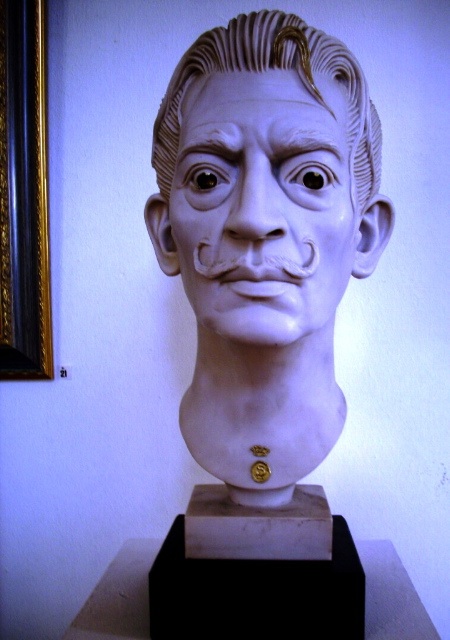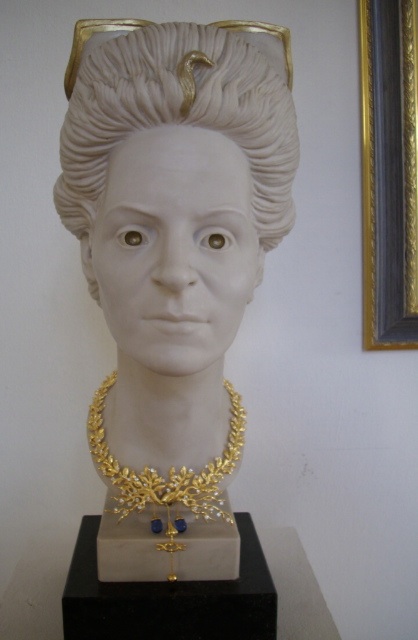Home
|
Prometheus Nr. 189
|
Alexander
Order
Salvador
Dalí at 109 years
Remembering a
genius who died 24 years ago
By B. John Zavrel

Salvador
Dalí.
Portrait by K.
Donst. The
life-size bust has been executed with the hair in the style that
Dalí used to wear at the beginning of his friendship with Coco
Chanel in Paris. The photo belongs to the
„Royal
Dalí Collection of the Museum Europäische
Kunst
(Noervenich Castle near Cologne, Germany).
Copyright: Foto: Marco-VG
Madrid/New York
(bpb)
Salvador Dalí exists in the unconscious of millions of people
around the world. He
was born on May 11, 1904 in the Spanish Figueres (Girona),
Catalonia.
So, his admirers can celebrate his 109th birthday anniversary in
2013. And
on January 23, 1989 his successful, excentric and often scurrilous
life came to an end.
That was 24 years ago. For the contemporaries who had known him
personally, in spite of all their respect, he remains "the crazy one
from Cadaques".
There are only few
artists in the Western culture about whom has been written as much as
about Salvador Dalí. And so it is that in book publication he
leads well ahead of Pablo Picasso, Marc Chagall and Jean Cocteau. And
what is reported about him is entirely positive. What is passed over,
even treated with silence, was his true attitude towards politics and
the historic events in Europe until 1945, which had changed the
world. Here and there, his "sympathies toward the Spanish dictator
Francisco Franco" are criticized. But these possible dark spots on
Dalí's white vest have never been put to rest, nor were
adequately explained.
As at the beginning
of 1930s the political situation became dangerous due to the
communist threat to Europe by Josef Stalin against his adversaries
Adolf Hitler (Germany) , Benito Mussolini (Italy) and Franco (Spain),
Dalí and his wife Gala moved away from this threatening
situation. They both travelled in 1934 for the first time to USA.
Pablo Picasso, who symphatized with the Communists, gave Dalí
the money for the journey, as was later reported. From 1939 to 1948
Dalí lived in the United States. After his return, good
relations developed between the artist and the dictator Franco. As an
example of the possibilities due to good relations with the
politician, Dalí reported in 1974 to a private circle of
friends: "As the Spanish fleet begun many years ago to do military
maneuvers in the gulf of Cadaques, I complained in a telephone call
with Caudillo Franco ("The Leader") about the accompanying noise and
disturbances. Shortly thereafter, a miracle happened quite
unexpectedly. There was quiet all around, the ships had
left."

Gala
Dalí,
the only wife of the artist. She died before him.
The
portrait-bust by Karolin Donst.
The masterful work is decorated with a necklace designed by
Dalí. On top of her hair one can recognize the famous bow
designed by Coco Chanel. The portrait belongs to the collection of
the European Art Foundation Germany (
www.europaeische-kultur-stiftung.org
)
Copyright: Marco-VG Bonn
Dalí and
the group of Surrealists
The French writer André Breton
is the most significant theoretician of Surrealism. He was an admirer
and friend of Dalí, but who eventually became one of his
critics. In the surrealist magazine "Minotaure", edited by Breton,
Dalí published in 1933 the article "About the edible beauty,
about the Art Nouveau Architecture". The article ended with the
proclamation "Beauty will be edible, or will not be at
all."
But in 1934 it came to tensions
within the surrealist group, oriented toward the Communists, in their
relations toward Dalí. The quarrel escalated due to
Dalí's painting "The Enigma of William Tell". It showed a
kneeling Lenin without pants with a large worker's cap and a
monstrous right buttock. Wilhelm Tell , according to Dalí's
own admission, represents Dalí's father as a cannibal, and
reveals his disturbed relationship to him. The small child on his arm
is Salvador, the basket at the feet of Tell contains the tiny child
that represents Gala, who is threatened by being crushed.
André Breton, in a letter
dated January 23, 1934, accused Dalí of the following:
antihumanism, defending the new and irrational phenomen of Adolf
Hitler, his admiration of academic painting as compared to the modern
painting style, the late defense of fatherly authority and family
values and concerning the painting, ultraconscious painting and
pursuing success.
In a reply letter, Dalí denied
all these accusations. To the main accusation point of fascism,
Dalí pointed out regarding his paintings": I am neither
actually nor even a symphatizer of Hitler."
In spite of all this, it came to the
expulsion of Dalí from the group of Surrealists around Breton,
who did not want to give up the leadership of the group. A surrealist
"general assembly" that Breton called together for February 5, 1934
at his apartment, decided that "Dalí has made himself
repeatedly guilty of counterrevolutionary actions, leading to the
admiration of Hitler's fascism. And the signatories suggested, in
spite of his declaration of January 25th, to expell him from the
circle of Surrealists for being a fascist element, and to fight
against him with all means." The conclusion was signed by nine
members: Victor Brauner, André Breton, Max Ernst, Herold,
Hugnet, Meret Oppenheim, Peret, Yves Tanguy and Caillos. Only Pierre
Yoyotte expressed his understanding of Dalí's position. These
accusations were on the other hand critizcized by Dalí's
friends as a reactions of envy toward Dalí's artistic
success.
Still, Dalí continued to
successfully participate in exhibitions of the group. Breton finally
realized that they could not give up this magnet attracting the
public. The accusations that he was a follower of fascism and Adolf
Hitler, Dalí finally adressed in his autobiography: "They
demanded [ ... ] from me that I should finally decide to be a
Stalinist or Hitlerist. No! [ ... ] I will remain until death
what I have always been, Dalí and only Dalí! I believed
neither in the Communist revolution, nor in the National Socialist
revolution."
The only thing
that interests me ...
From today's point of view, this is
to be said: No doubt, Dalí belongs to the most successful
artists of the 20th century. His loyal publisher, Captain Peter Moore
from Great Britain, has significantly contributed to his fame by his
publicity work. As a giant of the arts, Dalí liked to move in
the company of the beautiful, influential and successful people. That
was also the case already in 1920s, as he associated in Paris with
Coco Chanel. He had a high respect towards achievement and ability to
create. That lead in his old age to the "Friendship of the Golden
Triangle" with the sculptor of the century Arno Breker (Germany) and
the painter-prince Ernst Fuchs (Austria).
In spite of all euphoria for other
geniuses, Dalí made it understandable that above all, he loves
himself. Thus, he had himself called "the Divine". His admirers were
crazy about him. In certain time periods, his art collectors were as
if possessed by a mania, when it came to acquiring his lithographs
and etchings. Through the purchase of these works they rightly felt
themselves to be a part of the Master's work. Because artists and
their collectors belong together, like tires and a car.
Until Dalí's death it was a
happy time for the surrealist artist and his collectors. "We love
you", they told him again and again. And no one felt offended by the
provocative sayings that had multiple meanings. Realistic was the
exaggerated saying of Dalí, that is often quoted even to this
day: "The only thing that interests me is money."
(06-05.2013)
Disclaimer: The
contents of this article are of sole responsibility of the author(s).
The journal PROMETHEUS will not be responsible for any inaccurate or
incorrect statement in this article.
www.meaus.com
contains copyrighted material the use of which has not always been
specifically authorized by the copyright owner. We are making such
material available to our readers under the provisions of "fair use"
in an effort to advance a better understanding of political, economic
and social issues. The material on this site is distributed without
profit to those who have expressed a prior interest in receiving it
for research and educational purposes. If you wish to use copyrighted
material for purposes other than "fair use" you must request
permission from the copyright owner.
For media
enquiries:
info@meaus.com
Copyright 2013
Prometheus
PROMETHEUS,
Internet Bulletin for Art, News, Politics and Science, Nr. 189, May
2013